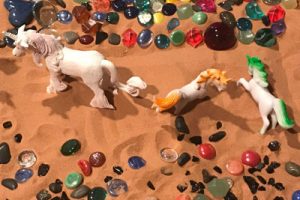 I receive many questions about sand tray therapy on a daily basis, so I thought this would be a good subject to post. I found this article and wanted to share as I found it to be an excellent description of sand tray therapy. Below has been adapted from an unknown author.
I receive many questions about sand tray therapy on a daily basis, so I thought this would be a good subject to post. I found this article and wanted to share as I found it to be an excellent description of sand tray therapy. Below has been adapted from an unknown author.
For a very long time, sand has been used as an intrigal ingredient in the construction of the world around us. Brick, glass, and concrete would not exist without sand and, thusly, neither would our modern framework as we know it. In a similar, more figurative sense, sand tray therapy uses sand to create a physical, symbolic model of an individual’s inner worlds and exclusive realities—or, perhaps more appropriately, their personal, psychological infrastructure. By using the sand tray as the canvas and a large assortment of miniature sand tray objects as the medium, sand tray therapy allows a burdened or distraught person to express him or herself in a way that is therapeutic for the individual and interpretable by the sand tray therapy practitioner. As simple as this process might seem, sand tray therapy intervention has been practiced, studied, and diversified for over seventy years and involves many different components and theories.
Sand tray therapy (also known as sandplay or The World Technique) was developed by Dr. Margaret Lowenfeld during the 1920s. Working as a pediatrician, she observed the importance of children’s play as a therapeutic device, as well as a window into their cognitive and psychological functioning. Applying this theory to child therapy, it was discovered that providing children with the tools to express themselves in their own unique way and learning to interpret the language of play can illuminate a great deal of important information about the child. When combined with the almost inexplicable soothing effects of sand, sand tray therapy was born as an innovative method of both healing and expression.
The physical tools involved in sand tray therapy (aside from sand) are a tabletop sand tray, and a large, assorted array of miniatures that can be manipulated by the child/adult inside the sand tray. A sand tray typically measures four-feet by three-feet, making it no larger than the sand tray therapy participant’s field of vision. Examples of sand tray miniatures include animals, people, furniture, vehicles, food, buildings, and so forth. The amount and variety of sand tray miniatures provided can correlate with the sand tray participant’s options for expression and, therefore, with the effectiveness of the sand tray therapy. Though all of these sand tray supplies are essential to the sand tray process, the most vital components of successful sand tray therapy relate to the technique of the sand tray therapist.
As with many other methods of play therapy, sand tray therapy must be conducted in a non-invasive manner. Since the goal of the sand tray therapist is to illicit and assess the true meanings of the world created in the sand tray, the child must feel completely uninhibited and free to express him or herself in whatever way their feelings guide them. Sand tray therapy does involve interaction between therapist and participant, but in a non-authoritative environment. The sand tray therapist invites the participant to tell a story or, perhaps, recreate a memory with the sand tray miniatures on the landscape of the sand tray. The specific choices and manipulations of the objects must be acutely observed by the sand tray therapist and explored through careful inquiry. Discussing the participant’s sand tray world can lead to revelations about struggles or anxieties, in-depth self-exploration, the development of strong coping skills, and, ultimately, a profound healing experience.
Though sand tray therapy was originally developed as a method of helping children articulate their emotions and experiences, it has since been embraced as a mode of expression and coping for adults, as well. The combination of exercising one’s creativity, shrinking complex realities down to a manageable size, and finding enjoyment in the process is what makes sand tray therapy unique. As this method is continually researched and practiced, it becomes increasingly useful in a wide variety of situations.
